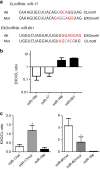Sumoylated hnRNPA2B1 controls the sorting of miRNAs into exosomes through binding to specific motifs
- PMID: 24356509
- PMCID: PMC3905700
- DOI: 10.1038/ncomms3980
Sumoylated hnRNPA2B1 controls the sorting of miRNAs into exosomes through binding to specific motifs
Abstract
Exosomes are released by most cells to the extracellular environment and are involved in cell-to-cell communication. Exosomes contain specific repertoires of mRNAs, microRNAs (miRNAs) and other non-coding RNAs that can be functionally transferred to recipient cells. However, the mechanisms that control the specific loading of RNA species into exosomes remain unknown. Here we describe sequence motifs present in miRNAs that control their localization into exosomes. The protein heterogeneous nuclear ribonucleoprotein A2B1 (hnRNPA2B1) specifically binds exosomal miRNAs through the recognition of these motifs and controls their loading into exosomes. Moreover, hnRNPA2B1 in exosomes is sumoylated, and sumoylation controls the binding of hnRNPA2B1 to miRNAs. The loading of miRNAs into exosomes can be modulated by mutagenesis of the identified motifs or changes in hnRNPA2B1 expression levels. These findings identify hnRNPA2B1 as a key player in miRNA sorting into exosomes and provide potential tools for the packaging of selected regulatory RNAs into exosomes and their use in biomedical applications.
Figures






Similar articles
-
The RNA-Binding Protein SYNCRIP Is a Component of the Hepatocyte Exosomal Machinery Controlling MicroRNA Sorting.Cell Rep. 2016 Oct 11;17(3):799-808. doi: 10.1016/j.celrep.2016.09.031. Cell Rep. 2016. PMID: 27732855
-
hnRNPA2B1 Associated with Recruitment of RNA into Exosomes Plays a Key Role in Herpes Simplex Virus 1 Release from Infected Cells.J Virol. 2020 Jun 16;94(13):e00367-20. doi: 10.1128/JVI.00367-20. Print 2020 Jun 16. J Virol. 2020. PMID: 32295924 Free PMC article.
-
hnRNPA2B1 inhibits the exosomal export of miR-503 in endothelial cells.Cell Mol Life Sci. 2020 Nov;77(21):4413-4428. doi: 10.1007/s00018-019-03425-6. Epub 2020 Jan 2. Cell Mol Life Sci. 2020. PMID: 31894362 Free PMC article.
-
Role and mechanisms of exosomal miRNAs in IBD pathophysiology.Am J Physiol Gastrointest Liver Physiol. 2020 Dec 1;319(6):G646-G654. doi: 10.1152/ajpgi.00295.2020. Epub 2020 Oct 7. Am J Physiol Gastrointest Liver Physiol. 2020. PMID: 33026230 Free PMC article. Review.
-
ExomiRs: A Novel Strategy in Cancer Diagnosis and Therapy.Curr Gene Ther. 2018;18(6):336-350. doi: 10.2174/1566523218666181017163204. Curr Gene Ther. 2018. PMID: 30332956 Review.
Cited by
-
SUMOylation promotes extracellular vesicle-mediated transmission of lncRNA ELNAT1 and lymph node metastasis in bladder cancer.J Clin Invest. 2021 Apr 15;131(8):e146431. doi: 10.1172/JCI146431. J Clin Invest. 2021. PMID: 33661764 Free PMC article.
-
Transgenerational epigenetic reprogramming of early embryos: a mechanistic model.Environ Epigenet. 2020 Jul 18;6(1):dvaa009. doi: 10.1093/eep/dvaa009. eCollection 2020 Jan. Environ Epigenet. 2020. PMID: 32704385 Free PMC article. Review.
-
A glimpse into the world of microRNAs and their putative roles in hard ticks.Front Cell Dev Biol. 2024 Sep 23;12:1460705. doi: 10.3389/fcell.2024.1460705. eCollection 2024. Front Cell Dev Biol. 2024. PMID: 39376631 Free PMC article. Review.
-
Intervening in hnRNPA2B1-mediated exosomal transfer of tumor-suppressive miR-184-3p for tumor microenvironment regulation and cancer therapy.J Nanobiotechnology. 2023 Nov 14;21(1):422. doi: 10.1186/s12951-023-02190-w. J Nanobiotechnology. 2023. PMID: 37957722 Free PMC article.
-
Transferring intercellular signals and traits between cancer cells: extracellular vesicles as "homing pigeons".Cell Commun Signal. 2016 Jun 10;14(1):13. doi: 10.1186/s12964-016-0136-z. Cell Commun Signal. 2016. PMID: 27282631 Free PMC article. Review.
References
-
- Thery C., Ostrowski M. & Segura E. Membrane vesicles as conveyors of immune responses. Nat. Rev. Immunol. 9, 581–593 (2009). - PubMed
-
- Valadi H. et al. Exosome-mediated transfer of mRNAs and microRNAs is a novel mechanism of genetic exchange between cells. Nat. Cell. Biol. 9, 654–659 (2007). - PubMed
Publication types
MeSH terms
Substances
Grants and funding
LinkOut - more resources
Full Text Sources
Other Literature Sources
Molecular Biology Databases
Miscellaneous

